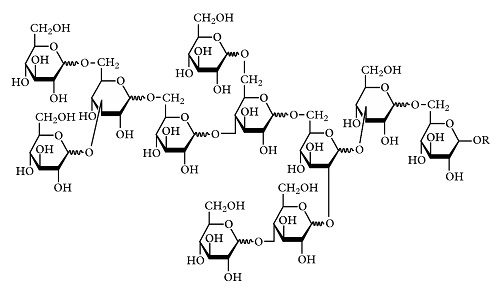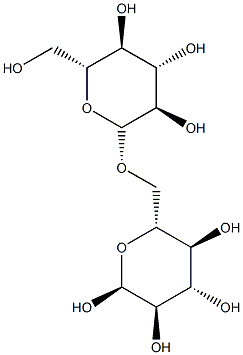폴리덱스트로오스
|
|
폴리덱스트로오스 속성
- 녹는점
- >130°
- 저장 조건
- 4°C, Hygroscopic
- 용해도
- Completely miscible in water. Sparingly soluble to insoluble in most organic solvents. Polydextrose has a higher water solubility than most carbohydrates and polyols, allowing the preparation of 80% w/w solutions at 20°C. Polydextrose is soluble in ethanol and only partially soluble in glycerin and propylene glycol.
- 물리적 상태
- 고체
- 물리적 상태
- 단단한 모양
- 색상
- 흰색에서 황백색까지
- 냄새
- 100.00%에서. 냄새 없는
- ?? ??
- 냄새 없는
- 안정성
- 흡습성
안전
| HS 번호 | 3913901000 |
|---|
폴리덱스트로오스 C화학적 특성, 용도, 생산
순도시험
(1) 액성 : 이 품목의 수용액(1→10)의 pH는 2.5 이상이어야 한다. 다만, 액체의 경우 수용액(1.4→10)의 pH를 측정한다.
(2) 단량체 : 이 품목 20mg(다만, 액체의 경우 고형분 20mg에 대응하는 양)을 정밀히 달아 마개있는 바이알에 취하고 이에 옥타데칸용액 1mL, 피리딘 1mL, N-트리메틸실릴이미다졸 0.5mL를 가하고 마개를 한 후 70℃의 초음파수욕에서 60분간 가열한 것을 시험용액으로 하고 따로 표준용액 1mL, 옥타데칸 용액 1mL, N-트리메틸실릴이미다졸 0.5mL를 시험용액과 동일하게 처리한 것을 반응표준용액으로 한다. 반응표준용액 및 시험용액 각각 일정량을 가스크로마토그래피에 주입하고 다음 계산식에 따라 각 단량체의 함량을 구할 때, 1,6-안히드로-D-글루코오스 4.0% 이하, 소비톨과 D-글루코오스를 합한 양이 6.0% 이하이어야 한다. 다만, 반응표준용액으로 2회 주입하여 평균값을 구한다.
W : 검체의 무게(mg)(회분을 제외한 무수물로서)
Ws : 각 표준물질의 무게(mg)
R : 검액 중의 옥타데칸 피크면적에 대한 각 단량체 피크넓이의 비
Rs : 반응표준용액 중의 옥타데칸 피크면적에 대한 각 단량체 피크넓이의 평균비
조작조건
칼 럼 : 내경 2mm, 길이 2.5m의 유리관 또는 스테인레스관
칼럼충전제 : 100~120메쉬의 가스크롬 큐(Gas Chrom Q)에 3% OV—1을 입힌 것.
검 출 기 : 수소염이온화검출기(FID)
주입구온도 : 210℃
칼럼온도 : 175℃
검출기온도 : 230℃
캐리어가스 및 유량 : 질소, 30mL/min
단량체의 용출순서는 1,6-안히드로-D-글루코오스(레보글루코산), n-옥타데칸, α-D-글루코오스, D-소비톨 및 β-D-글루코오스순이다.
표준용액 : α-D-글루코오스 50mg, β-D-글루코오스 50mg, 무수 D-소비톨 40mg, 1,6-안히드로-D-글루코오스 35mg을 각각 정밀히 달아 피리딘에 녹여 100mL로 한다.
옥타데칸용액 : 옥타데칸 50mg을 정밀히 취하여 피리딘에 녹여 100mL로 한다.
(3) 5-히드록시메틸푸르푸랄(HMF) : 이 품목 1g(다만, 액체의 경우 고형분 1g에 대응하는 양)을 정밀히 달아 100mL 메스플라스크에 취하고 물에 녹여 100mL로 한 것을 시험용액으로 하고 물을 대조액으로 하여 액층 1cm, 파장 283nm에서 흡광도를 측정하고 다음 계산식에 따라 5-히드록시메틸푸르푸랄의 함량을 구할 때, 그 양은 회분을 제외한 무수물에 대하여 0.1% 이하이어야 한다. 다만, 중화한 것은 0.05% 이하이어야 한다.
A : 시험용액의 흡광도
C : 시험용액의 농도(mg/mL)(회분을 제외한 무수물로서)
(4) 비소 : 이 품목을 비소시험법에 따라 시험할 때, 그 양은 4.0ppm 이하이어야 한다.
(5) 분자량한도 : 이 품목 4g(다만, 액체의 경우 고형분 4g에 대응하는 양)을 0.2M 인산완충액(pH 6.8)에 용해하여 100mL로 한 것을 검액으로 한다. 덱스트란표준품 T 70(분자량 74,300), T 40(분자량 40,600) 및 T 10(분자량 9,400) 각각 4g씩을 0.2M 인산완충액(pH 6.8)에 용해하여 100mL씩으로 한 것을 표준용액으로 하고 다음의 액체크로마토그래피 조작조건에 따라 표준용액 50μL씩을 주입하여 검량선을 작성하고 22,000 분자량에 해당하는 용출시간(t)을 구한다. 따로, 검액 50μL를 주입하여 용출시킬 때, t 이하에서는 주피크 높이의 2%가 넘는 피크가 있어서는 아니 된다.
조작조건
검 출 기 : 시차굴절계(RI Detector)
칼 럼 : TSK—GEL G—3000PW, 7.5mm×600mm 스테인레스관
칼럼온도 : 실온
이 동 상 : 0.2M 인산완충액(pH 6.8)
유 속 : 1.0mL/min
측 정 : 2×10-5 RIUFS
시 액
0.2M 인산완충액(pH 6.8)
제 1 액 : 인산일칼륨 27.218g을 취한다음 물을 가하여 1L로 한다.
제 2 액 : 인산이나트륨 71.6g을 취한다음 물을 가하여 1L로 한다.
제 2 액에 제 1 액을 가해주면서 잘 섞어 pH 6.8로 한다.
(6) 납 : 이 품목 5.0g(다만, 액체의 경우 고형분 5.0g에 대응하는 양)을 취하여 원자흡광광도법 또는 유도결합플라즈마발광광도법에 따라 시험할 때, 그 양은 0.5ppm 이하이어야 한다.
(7) 니켈 : 이 품목 5.0g(다만, 액체의 경우 고형분 5.0g에 대응하는 양)을 취하여 원자흡광광도법 또는 유도결합플라즈마발광광도법에 따라 시험할 때, 그 양은 2.0ppm 이하이어야 한다(수소환원한 것에 한한다).
확인시험
(1) 이 품목의 수용액(1→10) 1방울에 5% 페놀용액 4방울을 가하고 신속히 황산 15방울을 가할 때, 진한 황~오렌지색이 생성된다.
(2) 이 품목의 수용액(1→10) 1.0mL에 아세톤 1.0mL를 가하고 심하게 교반할 때, 용액은 투명하다.
(3) (2)의 시험용액에 아세톤 2.0mL를 가하고 심하게 교반할 때, 심한 우유상의 혼탁이 생긴다.
(4) 이 품목의 수용액(1→50) 1mL에 알칼리구연산동시액 4mL를 가하고 2~4분간 격렬히 끓인 후 정치하여 식힐 때, 상등액은 청~청록색이다.
정량법
이 품목 250mg(다만, 액체의 경우 고형분 250mg에 대응하는 양)을 250mL 메스플라스크에 취하여 물에 녹여 표선까지 채우고 이 액 10mL를 취하여 물을 가하여 250mL로 한다. 이 액 2mL씩을 3개의 바이알(8mL)에 취하고 이에 페놀용액(8→10) 0.12mL를 가하고 조용히 혼합한 다음 황산 5mL를 신속히 가하고 마개를 한 다음 격렬히 흔든다(고무장갑을 사용하며 안전가리개를 사용한다). 이를 상온에서 45분간 방치한 후 액층 1cm, 파장 490nm에서 흡광도를 측정한다. 따로 글루코오스표준용액 각각 2mL씩을 취하여 검액의 경우와 동일하게 처리하여 흡광도를 측정하여 농도에 대한 검량선을 작성하고 다음 계산식에 따라 중합체의 함량(P)을 구한다. 따로 물 2mL, 페놀용액(8→10) 0.12mL 및 황산 5mL를 검액과 동일하게 처리하여 대조액으로 한다.
A : 검액의 흡광도(평균)
Y : 검량선에서의 y절편
S : 검량선에서 얻어진 글루코오스농도(g/mL)에 대한 흡광도의 기울기(S는 약 0.02)
C : 검액의 농도(g/mL)(회분을 제외한 무수물로 환산한다)
Pg, P1 : 단량체시험에서 측정된 각각 글루코오스, 1,6-안히드로-D-글루코오스의 함량
시 약
글루코오스 표준용액 : α-D-글루코오스 100mg을 정밀히 달아 물에 녹여 500mL로 한다(200μg/mL). 이를 다시 희석하여 mL당 50, 40, 20, 10 및 5μg의 용액을 만든다.
정의
이 품목은 약간의 결합 소비톨과 구연산 또는 인산을 가지는 D-글루코오스의 무작위 축중합체이다. 알칼리를 이용하여 중화하거나 추가로 탈색 및 탈이온화한 것이 있으며, 부분적으로 수소환원한 것도 있다. 다만, 액체의 경우 70∼80%의 폴리덱스트로스를 함유하고 있다.
강열잔류물
이 품목 2g(다만, 액체의 경우 고형분 2g에 대응하는 양)을 취하여 강열잔류물시험법에 따라 시험할 때, 그 양은 0.3% 이하이어야 한다. 다만, 중화한 것은 2.0% 이하이어야 한다.
화학적 성질
Polydextrose occurs as an odorless, off-white to light tan powder with a bland, slightly sweet to slightly tart taste, dependent upon grade. Polydextrose is also available as a clear, light yellow to colorless liquid (70% dry substance), which is odorless with a slightly sweet taste.역사
Polydextrose (PDX) was invented at Pfizer Central Research during the late 1960s, and patented in 1973 (Rennhard 1973). It was originally developed as a reduced calorie (1· kcal/g) replacement for sugar, and partial replacer for fat, fl our and starch. PDX is prepared by vacuum thermal polymerisation of glucose, using sorbitol and an approved food acid as catalyst. Random polymerisation and branching yield various types of glycosidic bonds in the structure (1,6 bonds predominate) (Rennhard 1973; Allingham 1982). A representative structure is shown in Fig. 43.1. Improved versions of PDX (Litesse®) have been patented that utilise ion exchange and hydrogenation, and provide even broader utility in foods (Borden et al. 1997; Guzek et al. 1997a, b).
The structural compactness and complexity of PDX prevents mammalian enzymes from hydrolysing the molecule. This imparts reduced caloric content, as the majority of PDX passes through the stomach and enters the large intestine, whereupon it behaves as a dietary fi bre (Craig et al. 1998). This chapter discusses the physiological benefi ts and analytical measurement of PDX.
용도
Polydextrose is a bulking agent that is a randomly bonded conden- sation polymer of dextrose containing small amounts of bound sor- bitol and citric acid. it is a water-soluble powder providing a ph range of 2.5–3.5. it is partially metabolized which results in a caloric value of 1 cal/g. as a reduced-calorie bulking agent, it can partially replace sugars and in some cases fats in reduced-calorie foods. it also functions as a bodying agent and humectant. applications include desserts, specific baked goods, frozen dairy desserts, chewing gum, and candy. usage levels vary according to application, but examples are frozen dessert, 13–14%; puddings, 8–9%; and cake, 15–16%.생산 방법
Polydextrose is prepared by the bulk melt polycondensation of glucose and sorbitol in conjunction with small amounts of foodgrade acid in vacuo. Further purification steps are then involved to generate a range of products with improved organoleptic properties by the removal of acidity and flavor notes generated during the condensation reaction. A partially hydrogenated version of polydextrose, which is suited for high inclusion rates, for sugar-free applications, and where Maillard reactions are not required, is also available.Pharmaceutical Applications
Polydextrose is used in pharmaceutical formulations and food products. In food products it is used as a bulking agent; it also has texturizing and humectant properties. Although polydextrose can be used in a wide range of pharmaceutical formulations, its primary use is in solid-dosage forms.In tableting, polydextrose solutions are used as binders in wetgranulation processes. Polydextrose is also used in the manufacture of directly compressible tableting excipients. Polydextrose solutions may also be used, in conjunction with other materials, as a film and tablet coating agent.
Polydextrose acts as a bulking agent in the formulation of ‘sugarfree’ confectionery-type dosage forms. In conjunction with isomalt, lactitol, or maltitol, polydextrose can be used in the manufacture of ‘sugar-free’ hard-boiled candies and acacia lozenges or pastilles as a base for medicated confectionery.
The combination of high water solubility and high viscosity of polydextrose facilitates the processing of sugar-free candies of excellent quality. Polydextrose is amorphous and does not crystallize at low temperatures or high concentrations, so it can be used to control the crystallization of polyols and sugars and therefore the structure and texture of the final product.
부작용
Polydextrose is POSSIBLY SAFE when taken by mouth in doses of less than 50 grams per day. Polydextrose can cause intestinal gas (flatulence), bloating, stomach cramps, and diarrhea. Polydextrose is POSSIBLY UNSAFE when taken by mouth in single doses of more than 50 grams or in daily doses of more than 90 grams.Safety
Polydextrose is used in oral pharmaceutical applications, food products, and confectionery, and is generally regarded as a relatively nontoxic and nonirritant material.However, excessive consumption of non-digestible carbohydrates, such as polydextrose, can lead to gastrointestinal distress. After evaluating a series of clinical studies, the Joint FAO/WHO Expert Committee on Food Additives (JECFA) and the European Commission Scientific Committee for Food (EC/SCF) concluded that polydextrose was better tolerated than other digestible carbohydrates such as polyols. The committee concluded that polydextrose has a mean laxative threshold of approximately 90g/day (1.3 g/kg body-weight) or 50g as a single dose.
(mouse, oral): >30 g/kg
(rat, oral): >15 g/kg
저장
Polydextrose powder is hygroscopic and absorbs significant amounts of moisture at relative humidities greater than 60%. Under dry storage conditions, and in original sealed packaging, polydextrose powders can be expected to retain stability for at least 3 years. Solution grades have a shorter shelf-life of 3 to 6 months (dependent upon grade) at an ambient temperature of 25°C, although this can be extended to 12 months through the use of refrigeration.The bulk material should be stored in a cool, dry place in wellclosed containers.
비 호환성
Incompatible with oxidizing agents, strong acids, and alkalis, forming a brown coloration and depolymerizing.Regulatory Status
Approved as a food additive in over 60 countries worldwide, including Europe and the USA. Included in the FDA Inactive Ingredients Database (oral tablets). Included in non-parenteral medicines licensed in the UK. Included in the Canadian List of Acceptable Non-medicinal Ingredients.폴리덱스트로오스 준비 용품 및 원자재
원자재
준비 용품
폴리덱스트로오스 공급 업체
| 공급자 | 전화 | 이메일 | 국가 | 제품 수 | 이점 |
|---|---|---|---|---|---|
| Hefei TNJ Chemical Industry Co.,Ltd. | +86-0551-65418679 +8618949832763 |
info@tnjchem.com | China | 2986 | 55 |
| Across Biotech Jinan Co LTD | +8613031735486 |
frank@acrossbiotech.com | China | 105 | 58 |
| Hebei Mojin Biotechnology Co., Ltd | +86 13288715578 +8613288715578 |
sales@hbmojin.com | China | 12837 | 58 |
| Hebei Chuanghai Biotechnology Co,.LTD | +86-13131129325 |
sales1@chuanghaibio.com | China | 5893 | 58 |
| Hebei Kingfiner Technology Development Co.Ltd | +86-15532196582 +86-15373005021 |
lisa@kingfinertech.com | China | 2990 | 58 |
| Henan Fengda Chemical Co., Ltd | +86-371-86557731 +86-13613820652 |
info@fdachem.com | China | 20288 | 58 |
| Shaanxi TNJONE Pharmaceutical Co., Ltd | +8618092446649 |
sarah@tnjone.com | China | 1143 | 58 |
| Hebei Zhuanglai Chemical Trading Co.,Ltd | +8613343047651 |
admin@zlchemi.com | China | 3002 | 58 |
| Hebei Ganmiao New material Technology Co., LTD | +86-17332992504 +86-17332992504 |
sales8@hbganmiao.com | China | 299 | 58 |
| Capot Chemical Co.,Ltd. | +86-(0)57185586718 +86-13336195806 |
sales@capot.com | China | 29791 | 60 |






